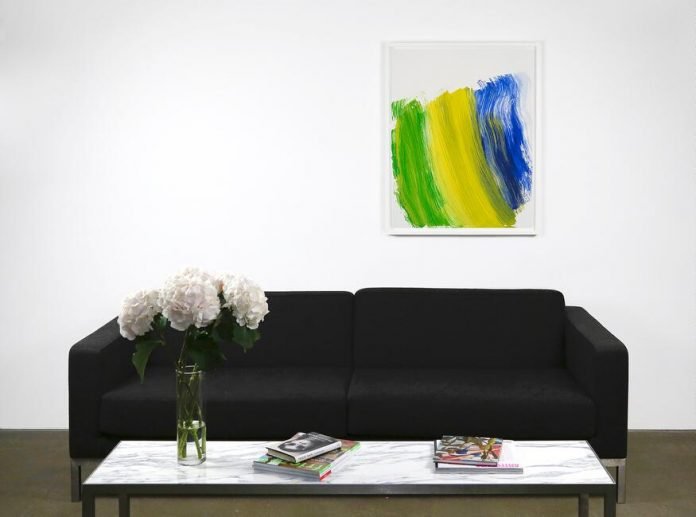This October, Sotheby’s will present for sale in London some 400 items from the personal collection of Howard Hodgkin. Highlights from the auction will be on exhibit at Sotheby’s Dubai from the 8-12th October, ahead of the auction in London 24 October 2017.
It was partly with the help of his cousin, Margery Fry, that when Hodgkin left school in 1949 he won a place at Camberwell Art School, and then moved on to the Bath Academy of Art, Corsham. At Camberwell, he was taught by leading Euston Road School painters Victor Pasmore and William Coldstream, and remembers considerable peer pressure to conform to a house style. “I was already an outsider even then,” he recalls, and by the time he went to Corsham, he already had his own artistic language. Critical recognition for his work grew steadily through the 1960s and 1970s, and by 1984 he was asked to represent Britain at the Venice Biennale, swiftly followed by being awarded the Turner Prize in 1984. Since then Hodgkin has been the subject of numerous major international exhibitions.
Just as his eye for the exceptional resonates through his paintings, Howard Hodgkin’s ability to identify the extraordinary in unexpected places was deployed in his incessant hunt for art and objects of exquisite beauty. While each of Hodgkin’s paintings evokes his response to a very particular place, person or situation, the items he surrounded himself with in his home offer a personal portrait of their owner, one of the greatest artists of our time. The kaleidoscope of objects he so carefully drew together take us behind his paintings and cast new light on his aesthetic innovations, revealing what inspired him and what he held close.
Ornamentation is a prominent thread that runs through the great variety of objects he was drawn to, from both India and Islamic cultures. He especially sought fragments – particular motifs, calligraphy, colours and textures appearing in Ottoman, Indian and Islamic tiles, textiles and rugs. Fragments of calligraphy were not sought after for their meaning, but purely for the visual language of their linear forms, and he honed in on specific parts of larger pattern schemes. In doing so he focused on small yet powerful details, freeing his imagination from the original form. He collected individual tiles from different periods and countries, spanning Kashan, Iznik and Mughal.
Howard Hodgkin redefined the way in which we look at the world; he developed a personal pictorial language that speaks of interactions and emotions. Just as his eye for the exceptional resonates through his paintings, his ability to identify the extraordinary in unexpected places was deployed in his incessant hunt for art and objects of exquisite beauty. While each of Hodgkin’s paintings evokes his response to a very particular place, person or situation, the items he surrounded himself with in his home offer a personal portrait of their owner, one of the greatest artists of our time. The kaleidoscope of objects he so carefully drew together take us behind his paintings and cast new light on his aesthetic innovations, revealing what inspired him and what he held close. This October, Sotheby’s will exhibit some 400 items from the personal collection of Howard Hodgkin to be sold at auction in London on 24th October 2017.
The objects with which he was surrounded reflected his passions, influences and interests and nourished his paintings. As items were purchased he would find a space for them, move them around and then finally settle on a place he felt they should stay, according to the other objects around them, creating dynamic visual dialogues. Objects from Italy to India, which suggest a modern day grand tour, were displayed side by side, heightened by the jewel-like tones with which the walls of his London home were painted. Spanning art history through time and geography, they offer a vivid revelation of his private world in all its intense and exhilarating glory.
Speaking of his creative method, his partner Antony Peattie explains, ‘most of his work took place in his mind’. His compositions and strokes were envisaged before he took up the paintbrush, enabling him to execute his vision with swift, confident brushstrokes. ‘”It’s all grist to the mill”, Howard insisted… He collected in order to create new work. What he acquired fed into his work.”
Howard did not keep his own work as he said they got in the way of new work, though he did keep two paintings from his debut show at the ICA in 1962, Bedroom and Travelling. “I have absolutely no desire to collect my own work, but do have what with age seems an almost unquenchable thirst for acquiring other things to look at,” Howard stated. “I think of collecting as a sort of virus really, and I was infected… It is an addiction”. So much so that he kept auction catalogues and a tape measure by his bed, marking things that he fell in love with.
Speaking of the forthcoming sale Antony Peattie said: “Howard liked the idea of a sale after his death. The objects have served their purpose to him, they were what he called his ‘Must Haves’ that, in some mysterious way, fed his work. But now they amplify his absence. After he died the house was so sad: all these objects remained in place but, after 33 years that we spent together, everything had changed. The sale represents a personal portrait of Howard. And it will enable his executors to fulfil his wishes.”

